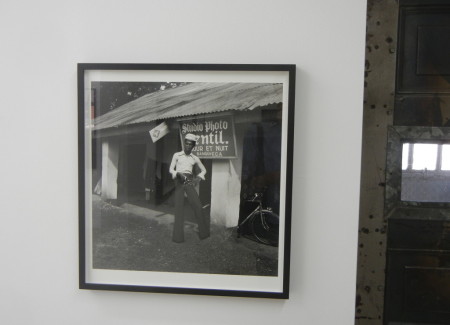JTF (just the facts): A total of 39 black and white and color photographs, generally framed in black and unmatted or unframed and pinned directly to mounts, and on display against white walls in the main gallery and against the bookshelves in the library area. While the checklist did not provide detailed information on processes employed, physical dimensions, or edition sizes, the works include at a minimum early gelatin silver prints, Polaroids, and more recent chromogenic prints, spanning the years between 1975 and 2013. (Installation shots below.)
Comments/Context: When we think about the long history of photographic self portraiture, the conventional wisdom connects artists like Cahun, Sherman, Wearing, Morimura and others into a thematic subset of those who have explored gender roles and stereotypes using themselves as the primary subject. This smart survey of the work of Samuel Fosso reminds us that especially in the world of fine art photography, new discoveries (and rediscoveries) make these groupings subject to future modification and reinterpretation. The excellent work on view in this retrospective-style show not only puts the relatively unknown Fosso squarely among those other esteemed names of self portraiture, it adds another important piece to the coalescing historical puzzle of contemporary African photography.
The exhibit opens chronologically with Fosso’s studio work from Bangui (Central African Republic), which he began as a thirteen year old in the mid 1970s. The liveliness of Fosso’s small vintage prints from the 1970s and 1980s separates him from his better known West African studio counterparts (Keïta and Sidibé); while contrasting fabrics and pop culture props are a common thread for all of the portraitists, Fosso’s portraits are looser, capturing the movement of genuinely tender embraces and funky kung fu poses.
At night, Fosso began his experimentation with self portraiture, and his personal pictures from the mid 1970s are full of constant re-styling, role playing, and imitation. At that time, Fosso seemed to exude an effortless, slinky cool, mixing fashions like high waisted bell bottoms and wide collared open necked shirts with outlandish sunglasses; riskier shots found him posing in his underwear or adding in an unexpected prop (a rubber glove, a red hat, a bunch of cyclamens). The photographs have real energy and punch, and signal a desire to push beyond conventional boundaries in the definition of identity.
The show then jumps forward a decade or two to the late 1990s, and finds Fosso making much more sophisticated, layered, and often satirical images. The Tati series (commissioned by the Paris department store) is particularly biting, walking the fine line between ridiculous mockery and knowing insight, pushing on post-Colonial realities. His natty golfer in a plaid vest and golf shoes (surrounded by fake potted plants) feels at first like light comedy, then turns a bit darker in its mimicry of Africans taking on Western roles and styles. The flip side of this satire comes in his image of a tribal chief in pelts and a fur hat, decorated with hip sunglasses and red loafers; the printed fabric backdrop of mirrors reinforces the idea of looking critically at what the local chiefs and politicians have become. His colorful image in drag as a liberated Back to Africa American woman in a patchwork suit of printed fabrics and red high heels has its own complicated undercurrent of conflicted identity. Seen as a series, Fosso’s use of stylistic exaggeration to highlight types and roles is consistently strong, full of surprising nuance and complexity.
Fosso’s recent African Spirits series employs his deft personal mimicry in a more specific manner, recreating famous images of public figures, from Muhammad Ali and Malcolm X to Patrice Lumumba and Tommie Smith. Hung together on one wall, the black and white portraits feel brightly interconnected, with Fosso alternately peering down as Martin Luther King Jr. in a mugshot, Halie Selassie in coronation garb, and Angela Davis in a huge afro. These reenactments and personifications powerfully link the history of photography (via the restaged appropriated images) and the history of African/African-American political culture, making each now universal icon more personal. A single large scale photograph from Fosso’s most recent body of work (from 2013) takes this idea in an adjacent direction, Fosso styling himself as Mao and wryly commenting on the increasing Chinese presence in contemporary Africa; it seems he’s not done using self portraiture to incisively probe the African experience.
All in, this is the kind of well edited show that we have come to expect from the Walther Collection – a thoughtful, scholarly examination of an artist that deserves more recognition and has not yet been widely discovered or embraced by the New York gallery and museum community. As seen here, Samuel Fosso has delivered a wealth of accomplished photography across his forty year career, continually using self portraiture as a vehicle for social examination and commentary. Hopefully this introductory show will open some doors for Fosso to step into his rightful place in the photographic dialogue.
Collector’s POV: Samuel Fosso is represented by Galerie Jean Marc Patras in Paris (website unavailable). Fosso’s work has very little secondary market history, so gallery retail remains the best option for those collectors interested in following up.

















